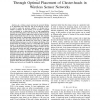Free Online Productivity Tools
i2Speak
i2Symbol
i2OCR
iTex2Img
iWeb2Print
iWeb2Shot
i2Type
iPdf2Split
iPdf2Merge
i2Bopomofo
i2Arabic
i2Style
i2Image
i2PDF
iLatex2Rtf
Sci2ools
106
Voted
ICC
2007
IEEE
2007
IEEE
On Achieving Maximum Network Lifetime Through Optimal Placement of Cluster-heads in Wireless Sensor Networks
—In a wireless sensor network, the network lifetime is an important issue when the size of the network is large. In order to make the network scalable, it is divided into a number of clusters. In each cluster, a set of nodes is grouped and coordinated by a cluster-head. Due to high computations and data forwarding tasks at the cluster-heads, cluster-heads get drained out sooner. Hence, high power nodes are used as clusterheads. Cluster-heads that are far away from the sink transmit their data packets via intermediate cluster-heads in a multi-hop fashion to the sink. Thus the cluster-heads that are near to the sink get overloaded and drained out sooner due to which the network lifetime decreases. In order to balance the lifetime of the cluster-heads, the existing works try to find either the optimum density or the optimum transmission range for the cluster-heads. The cluster-head placement algorithms should consider the fact that the node density and their transmission ranges are rel...
Related Content
| Added | 02 Jun 2010 |
| Updated | 02 Jun 2010 |
| Type | Conference |
| Year | 2007 |
| Where | ICC |
| Authors | Marudachalam Dhanaraj, C. Siva Ram Murthy |
Comments (0)

